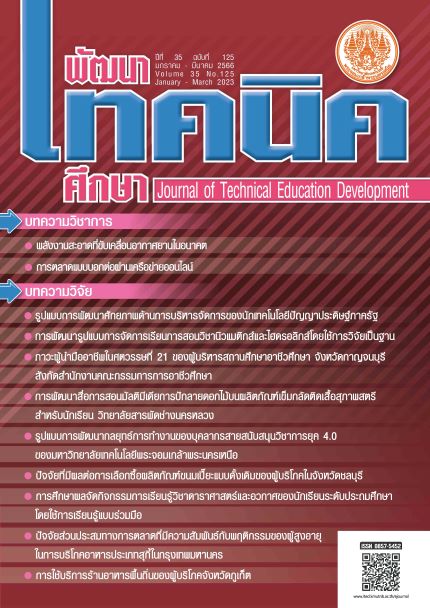พลังงานสะอาดที่ขับเคลื่อนอากาศยานในอนาคต
Main Article Content
บทคัดย่อ
บทความวิชาการฉบับนี้มุ่งศึกษาในเรื่องของพลังงานสะอาดที่ขับเคลื่อนอากาศยานในอนาคต ซึ่งส่งผลกระทบต่อสภาพแวดล้อมที่มีผลมาจากการปล่อยมลพิษจากอากาศยานและอุตสาหกรรมการบิน เพื่อเป็นการสร้างแรงบันดาลใจให้เกิดการคิดค้นและพัฒนานวัตกรรมใหม่ให้สามารถนำไปประยุกต์ใช้ และลดการปล่อยมลพิษที่ทำลายสิ่งแวดล้อมในอนาคต
จากการศึกษาพบว่าการที่อากาศยานและอุตสาหกรรมการบินปล่อยมลพิษจากการขับเคลื่อนอากาศยานนั้น เป็นสาเหตุทำให้เกิดสิ่งที่เรียกว่ามลพิษต่อสภาพแวดล้อมและส่งผลกระทบต่อชีวิตความเป็นอยู่และความปลอดภัยในสุขภาพต่างๆ ไม่ว่าจะเป็นอุณหภูมิที่สูงขึ้นในแต่ละปี ฤดูกาลที่เปลี่ยนแปลงไปจากเมื่อก่อน เป็นสิ่งที่ทางอุตสาหกรรมการบินควรตระหนักและมีแนวทางในการพัฒนาเพื่อลดการปล่อยมลพิษจากอากาศยาน ทั้งในด้านเครื่องยนต์ของอากาศยาน ชิ้นส่วนของอากาศยาน หรือสนามบินที่อากาศยานใช้ในการขึ้นลง จะต้องมีมาตรการต่างๆในการลดการปล่อยมลพิษให้มากขึ้น โดยผู้ผลิตหรือนักพัฒนาจะต้องใส่ใจในการออกแบบและคิดค้นวิธีในการทำให้การขนส่งของอากาศยานที่เป็นมิตรกับสิ่งแวดล้อม การใช้พลังงานทางเลือก หรือพลังงานสะอาด การขับเคลื่อนเครื่องบินในลักษณะของมอเตอร์ไฟฟ้าหรือระบบ hybrid และยานพาหนะที่ใช้ในสนามบิน เปลี่ยนจากระบบสันดาปมาเป็นการขับเคลื่อนด้วยพลังงานไฟฟ้า เพื่อชดเชยมลพิษที่เกิดจากการเผาไหม้แบบเดิม ส่งผลให้ สามารถลดการทำลายต่อสิ่งแวดล้อมภายในสนามบินและบริเวณโดยรอบภายในอนาคตต่อไป
Article Details

อนุญาตภายใต้เงื่อนไข Creative Commons Attribution-NonCommercial-NoDerivatives 4.0 International License.
เอกสารอ้างอิง
Cohen, B. S., Bronzaft, A. L., Heikkinen, M., Goodman, J., & Nádas, A. (2007). Airport- related air pollution and noise. Journal of occupational and environmental hygiene, 5(2), 119-129.
Kaya, S. K., & Erginel, N. (2020). Futuristic airport: A sustainable airport design by integrating hesitant fuzzy SWARA and hesitant fuzzy sustainable quality function deployment. Journal of Cleaner Production, 275, 123880.
Baxter, G., Srisaeng, P., & Wild, G. (2018). Sustainable airport waste management: The case of Kansai international airport. Recycling, 3(1), 6.
Grönstedt, T., & others. (2016, June). Ultra low emission technology innovations for mid- century aircraft turbine engines. In ASME Turbo Expo 2016: Turbomachinery Technical Conference and Exposition. American Society of Mechanical Engineers Digital Collection.
Goonetilleke, A., Yigitcanlar, T., Ayoko, G. A., & Egodawatta, P. (2014). Sustainable urban water environment: Climate, pollution and adaptation. Cheltenham, UK: Edward Elgar.
Marques, G., & Pitarma, R. (2019). Noise monitoring for enhanced living environments based on Internet of things. In World Conference on Information Systems and Technologies (pp. 45-54). Springer, Cham.
Hudda, N., Durant, L. W., Fruin, S. A., & Durant, J. L. (2020). Impacts of aviation emissions on near-airport residential air quality. Environmental Science & Technology, 54(14),
-8588.
Behmel, S., Damour, M., Ludwig, R., & Rodriguez, M. J. (2016). Water quality monitoring strategies—A review and future perspectives. Science of the Total Environment, 571, 1312-1329.
Penn, S. L., Boone, S. T., Harvey, B. C., Heiger-Bernays, W., Tripodis, Y., Arunachalam, S., & Levy, J. I. (2017). Modeling variability in air pollution-related health damages from individual airport emissions. Environmental research, 156, 791-800.
Fajersztajn, L., & others (2019). Health effects of pollution on the residential population near a Brazilian airport: A perspective based on literature review. Journal of Transport & Health, 14, 100565.
Stevens, B. L., Lewis, F. L., & Johnson, E. N. (2015). Aircraft control and simulation: dynamics, controls design, and autonomous systems. John Wiley & Sons.
Jung, J., Nag, S., & Modi, H. C. (2019, September). Effectiveness of Redundant Communications Systems in Maintaining Operational Control of Small Unmanned Aircraft. In 2019 IEEE/AIAA 38th Digital Avionics Systems Conference (DASC) (pp. 1-7). IEEE.
Zhang, J., & others (2018). Aircraft control surfaces using co-flow jet active flow control airfoil. In 2018 Applied Aerodynamics Conference (p. 3067).
Budd, L., Griggs, S., & Howarth, D. (2013). Sustainable aviation futures. Emerald Group Publishing.
Grobler, C., & others (2019). Marginal climate and air quality costs of aviation emissions. Environmental Research Letters, 14(11), 114031.
Hoelzen, J., & others (2018). Conceptual design of operation strategies for hybrid electric aircraft. Energies, 11(1), 217.
Donateo, T., De Pascalis, C. L., & Ficarella, A. (2019). Synergy effects in electric and hybrid electric aircraft. Aerospace, 6(3), 32.


